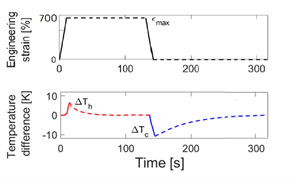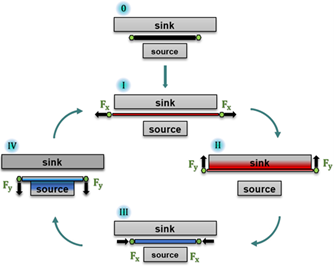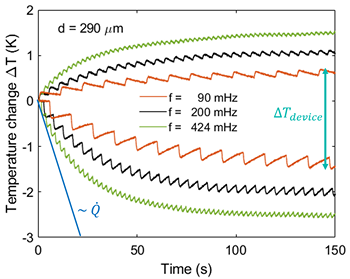Elastocaloric Cooling Based on Natural Rubber
What makes elastocaloric cooling a hot topic? Cooling applications are responsible for about 17% of global electricity consumption. This is of major concern since most cooling systems rely on vapor-compression devices, which have a global warming potential (GWP). Therefore, environmentally friendly cooling technologies are demanded. Solid-state cooling, utilizing stress-induced thermal changes such as the elastocaloric effect, has the potential to address this gap.
Elastomers like natural rubber (NR) which show a pronounced elastocaloric effect may provide a cost-effective solution with low loading forces and excellent fatigue resistance. The elastocaloric effect in NR is associated with the strain induced crystallization and entropy elasticity. During mechanical loading, polymer chains are orienting and crystals are formed, which lead to an entropy change and a subsequent temperature increase. After thermal equilibration in stretched state and subsequent rapid unloading at large strain rate (4.7 s−1), reverse transformation leads to a temperature decrease, which can be exploited for cooling (Figure 1).

Figure 1: Time-resolved evolution of applied strain and corresponding temperature difference ΔT of a natural rubber (NR) foil.
A schematic of an elastocaloric cooling cycle, based on elastomers can be seen in Figure 3. The cooling cycle involves mechanical rapid loading (1), heat release to the heat sink (2), followed by rapid unloading (3), and heat absorption from the heat source (4). Heat transfer is accomplished through solid mechanical contact between the elastocaloric material and the heat sink or source. Figure 3 presents the temperature variations over time for the heat sink and heat source at different operating frequencies in a demonstrator device equipped with a 290 μm thick NR foil.

Figure 2: Schematic of an elastocaloric cooling cycle.
A cooling power of 210 mW and specific cooling power of 3.4 Wg-1 could be achieved. The use of NR foils as refrigerant materials with large surface-to-volume ratio enhances heat transfer speed and increase cycling frequencies. Due to the large latent heat and high efficiency of phase transformation, elastocaloric cooling can, in principle, compete with state-of-the art refrigerators, while completely avoiding the use of environmentally harmful greenhouse gases.

Figure 3: The temperature changes in the heat sink and heat source compared to room temperature in a elastocaloric cooling demonstrator device using a 290 μm thick NR foil. The operating frequency is varied between 90 and 424 mHz [3].
Publication list
- C. Ludwig, J. Leutner, O. Prucker, J. Rühe, and M. Kohl, “Miniature-scale elastocaloric cooling by rubber-based foils,” JPhys Energy, vol. 6, no. 1, p. 015009, Nov. 2023, doi: 10.1088/2515-7655/ad0cff.
- C. Ludwig, J. Leutner, O. Prucker, J. Rühe, and M. Kohl, “Natural Rubber Foil-Based Elastocaloric Cooling,” in ACTUATOR 2024 International Conference and Exhibition on New Actuator Systems and Applications, Jun. 2024, pp. 132–135.
- C. Ludwig and M. Kohl, “Bistability-enhanced elastocaloric cooling device based on a natural rubber foil,” Journal of Applied Physics, vol. 136, no. 16, p. 165001, Oct. 2024, doi: 10.1063/5.0231213.
Contact
- M.Sc. Carina Ludwig [Contact]

